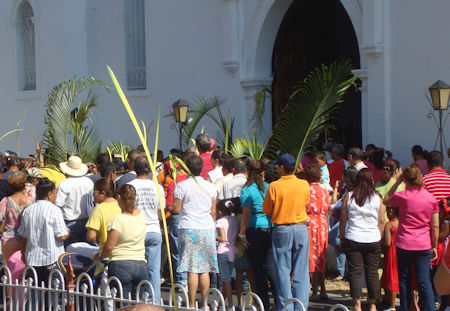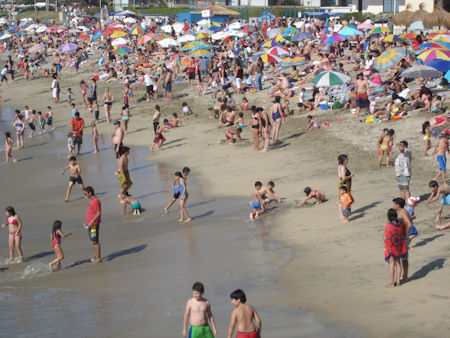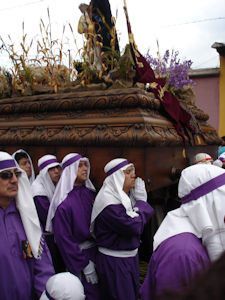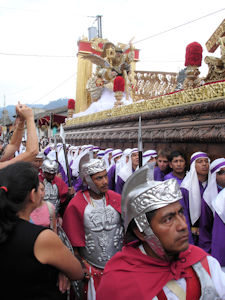 |  |
By Greg Niemann

“Semana Santa” (or Holy Week), the week preceding Easter Sunday “Domingo de Pascua,” is not only one of Mexico’s most important religious celebrations, but also a break time for most families.
During Holy Week, Christians throughout the world commemorate an important part of their faith and for the many Christian families in Baja California, the rest of Mexico, and most of Latin America for that matter, the celebrations are centered on religious activities.
Although primarily a reverential time, Semana Santa is also a time for Mexicans to vacation. Children generally get two weeks off from school (This year schools in Mexico are closed from April 6 to April 17, 2020). Many companies also shut down for that period so that their employees can spend time with their families. And traveling seems to be a high priority, especially to beaches, parks, and other outdoor destinations.
Beaches tend to fill up all week throughout Mexico. Along the Baja California coast you’ll see locals, from small groups to big extended families as they congregate on the beaches from Playas de Tijuana to Rosarito, Ensenada, and beyond. Semana Santa becomes the Mexican version of Spring Break.
On our April honeymoon some many years ago, my wife and I drove from Mazatlán to Puerto Vallarta on the Mexican mainland. When we discovered all along the way that every beach was crammed with partying Mexicans we realized just how much they take advantage of the week. It was hard to find hotel rooms in the entire area.
Many Mexicans also observe the week following Pascua as part of this vacation period. Numerous Bajacalifornianos will take 10 days to two weeks for vacations, especially government employees, making it difficult to complete business during that time. If you are doing banking or interacting with government offices be sure to confirm their holiday schedule. Baja businesses that are open during this popular vacation period also tend to be short staffed.
It's Spring Break Time

Of course, adding to the crowds of locals are the many gringos from across the border. After all, Semana Santa often coincides with the gringo Spring Break time and American students also like to put on their party faces.
For example, catering to visiting American students, Papas and Beer in Rosarito is offering Spring Break Packages every weekend this year from March 11-April 12. The packages include various parties, games, and different artist performances each weekend. The Rosarito Beach Hotel also offers special Easter events. And Easter winery tours are offered in Ensenada.
What all this time off this means for travelers to Baja is to plan early, make reservations where you can, and expect to see crowds, especially in the resort areas like Rosarito, Ensenada, and San Felipe.
There are numerous celebrations, both secular and religious, surrounding Holy Week and many have been around for centuries, arriving in Mexico with the Spanish. As a case in point, back in the 1800s Mexican novelist and National Poet Guillermo Prieto (1818-1897) wrote:
“From Holy Thursday to Easter Sunday throngs of people danced through the streets, in a movable feast of popular cuisine. Thirsty revelers guzzled aguas frescas, refreshing waters flavored with pineapple, melon, tamarindo, and chia seeds, dispensed by women from palm-frond and flower-decorated stands. Holy Week also marked the traditional start of Mexico City’s ice cream season, these frozen treats made with ice carried down from the slopes of Popocatépetl.”
A Week of Religious Celebrations
Along with the party atmosphere, most Mexicans tend to split their time off with the religious ceremonies. Semana Santa celebrates the last days of the Christ's life, with Pascua the celebration of the Resurrection. It is also the end of the 40-day period of sacrifices called Lent. Considering Mexico is almost 90 percent Catholic there is little surprise as to why Semana Santa is so reverently celebrated.

This year Semana Santa begins on April 5, Palm Sunday “Domingo de Ramos,” and ends Easter Sunday “Pascua, or Domingo de Resurrección” (April 12, 2020.) Some of the religious celebrations that occur during Semana Santa are:
Palm Sunday: Blessing of Palms. Catholics gather in churches for the blessing of palm fronds or crosses or other figures made from palms. Some of these palms are burned and saved for the next year’s Ash Wednesday. In front of most churches are palm leaf vendors, and churches become so crowded many have to stand outside.
Jueves Santo (Maundy Thursday): It commemorates the Washing of the Feet and the Last Supper. On Thursday of Semana Santa parish priests consecrate a sacred oil and balsam mixture called the Chrism for use in sacraments.
Viernes Santo (Good Friday): Passion plays are staged in many Catholic parishes as a reenactment of the Via Cruz (The Way of the Cross). Many parishes will also host processions, and hundreds of people, many in traditional robes, can be seen parading around in the streets, usually carrying an effigy of Christ and the cross, near the parish. The celebration usually includes a simulated crucifixion.
Sábado de Gloria (Holy Saturday): This day includes a vigil and a solemn mass in most parish churches.
Domingo de Pascua (Easter Sunday): For Mexican Catholics this is considered the most important day of the year. They are expected to attend Mass and churches usually are full. In many areas there are also religious processions, vigils, and other reenactments on Easter Sunday itself.
Combining the decidedly Christian holiday with vacation time, many churchgoers try to fit both into the week. One young student admitted to a reporter: “You can go to the beach on some days, and spend Good Friday and Easter Sunday in church. Those are the most important days after all.”

Semana Santa is comparable to the American Fourth of July period for outdoor activities and the use of vacation time. In addition to the religious and time off activities, many families take the opportunity to visit their home cities, so along with the party goers, roads everywhere tend to be more crowded than usual.
What About Eggs and Bunnies?
In case you might be wondering, where’s the Easter Bunny and hiding Easter Eggs? Due to proximity to the U.S. and being influenced by things American, many Baja California families do get into American-type activities. So you likely will see children searching for the coveted Easter Eggs in their yards or public parks.
But the Mexican version of the Easter egg tradition is not hiding the eggs as much as breaking them. Called cascarones (eggshells) they are hollowed-out chicken eggs filled with confetti or small toys and brightly colored. The fun is derived from breaking the egg over someone’s head and watching the confetti shower. Some people think that the confetti shower brings good luck and good fortune but for children the pleasure is simply breaking the eggs and enjoying the ensuing flutter of colors.
It’s not common, however, to see the Easter Bunny in Baja. You’ll see a lot of people in church, a lot of people at the beach, and if you see a grinning kid approaching with a colorful egg, be prepared to be showered with confetti.
About Greg
Greg Niemann, a long-time Baja writer, is the author of Baja Fever, Baja Legends, Palm Springs Legends, Las Vegas Legends, and Big Brown: The Untold Story of UPS. Visit www.gregniemann.com.

Have used different times with different vehicles and each time was very simple - each time we have...

Was quick, easy super straight forward!!

Convenient, great website, prices are reasonable.